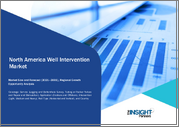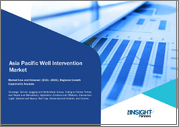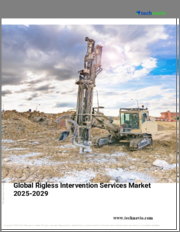
|
시장보고서
상품코드
1800937
유정 개입 시장 보고서 : 서비스 유형별, 갱정 유형별, 용도별, 지역별(2025-2033년)Well Intervention Market Report by Service Type, Well Type, Application, and Region 2025-2033 |
||||||
세계 유정 개입 시장 규모는 2024년 83억 달러에 달했습니다. IMARC Group은 2033년까지 이 시장이 114억 달러에 달하고, 2025-2033년 3.6%의 연평균 성장률(CAGR)을 보일 것으로 예측했습니다. 성숙 유전 및 가스전 증가, 정유제품 수요 증가, 급속한 기술 발전, 석유 및 가스 수요 증가 등이 유정개입 시장 점유율을 높이는 요인으로 작용하고 있습니다.
유정 개입 시장 동향 :
오프쇼어 분야 투자 증가
오프쇼어 플랫폼에 대한 투자 증가가 시장을 주도하고 있습니다. 미국, 중국, 러시아, 노르웨이 등 업스트림 주요 국가들의 주요 우선순위는 기존 유정에서의 유정 회수 확대와 신규 저류층 개발입니다. 그 결과, 완성, 개입, 해양 시추, 부유식 플랫폼, 워크오버 서비스 등 유전 서비스에 대한 수요가 전 세계적으로 증가하고 있습니다. 심해와 같은 해양 지역에는 쉽게 접근할 수 없는 대량의 석유 및 가스가 존재합니다. 따라서 기업은 이러한 자원에 도달하는 방법을 찾기 위해 더 많은 비용을 지출하고 있습니다. 이러한 해양 유전이 계속 잘 작동하기 위해서는 유정 개입이 필요합니다. 이는 문제를 해결하고 유정이 가능한 한 많은 석유 및 가스를 생산할 수 있도록 도구와 기술을 최대한 활용하는 것을 의미합니다.
유정 운영 효율성 향상에 대한 관심 증가
지능형 디지털화된 장비, 서비스, 솔루션의 채택이 증가하는 이유는 운영 효율성 향상에 대한 중요성이 강조되고 운영 비용과 자본 비용이 감소하고 있기 때문입니다. 데이터 분석, 최신 기술, 무선 이동성, 데이터 수집 플랫폼의 광범위한 활용을 통해 성능과 의사결정을 크게 향상시킬 수 있습니다. 지능형 의사결정, 분석, 효율적인 측정, 모델링은 모두 생산 최적화 프로세스의 일부이며, 유전의 석유 생산량을 더욱 향상시킬 수 있습니다.
석유 및 가스 산업에서의 발견 증가
유정 개입 시장은 유전 매장량에서 석유 및 가스 발견 증가와 유정에서 생산량을 증가시키는 놀라운 기술 발전의 결과로 상승할 것입니다. 미국 알래스카, 이스라엘 골란 고원, 텍사스 서부 알파인 하이, 티라피아의 스텁록, 옐로우테일(석유), 하이마라(가스 콘덴세이트), 랭 레바-1RDR2 시추정을 통한 해상 가스 발견은 점점 더 많은 관심을 받고 있는 발견의 일부에 불과합니다. 향후 몇 년 동안 석유 가격은 상승할 것으로 예측됩니다. 이를 통해 독립적인 탐사 회사, 가스 생산 회사, 유전 운영자의 석유 및 가스 발견 및 탐사 활동에 대한 투자를 촉진할 것으로 예측됩니다.
목차
제1장 서문
제2장 조사 범위와 조사 방법
- 조사 목적
- 이해관계자
- 데이터 소스
- 1차 정보
- 2차 정보
- 시장 추정
- 보텀업 접근
- 톱다운 접근
- 조사 방법
제3장 주요 요약
제4장 서론
제5장 세계의 유정 개입 시장
- 시장 개요
- 시장 실적
- COVID-19의 영향
- 시장 예측
제6장 시장 분석 : 서비스 유형별
- Logging and Bottomhole Survey
- Tubing/Packer Failure Repair
- Stimulation
- Sand Control
- Zonal Isolation
- Artificial Lift
- Fishing
- 기타
제7장 시장 분석 : 갱정 유형별
- 수직 갱정
- 수평 갱정
제8장 시장 분석 : 용도별
- 온쇼어 용도
- 오프쇼어 용도
제9장 시장 분석 : 지역별
- 북미
- 미국
- 캐나다
- 아시아태평양
- 중국
- 일본
- 인도
- 한국
- 호주
- 인도네시아
- 기타
- 유럽
- 독일
- 프랑스
- 영국
- 이탈리아
- 스페인
- 러시아
- 기타
- 라틴아메리카
- 브라질
- 멕시코
- 기타
- 중동 및 아프리카
제10장 SWOT 분석
제11장 밸류체인 분석
제12장 Porter의 Five Forces 분석
제13장 가격 분석
제14장 경쟁 구도
- 시장 구조
- 주요 기업
- 주요 기업 개요
- Aker Solutions
- Archer Limited
- Baker Hughes Company(General Electric)
- China Oilfield Services Ltd.(China National Offshore Oil Corporation)
- Expro Group
- Halliburton Company
- Schlumberger Limited
- Scientific Drilling International Inc.
- Superior Energy Services Inc.
- Vallourec
- Weatherford International Plc
The global well intervention market size reached USD 8.3 Billion in 2024. Looking forward, IMARC Group expects the market to reach USD 11.4 Billion by 2033, exhibiting a growth rate (CAGR) of 3.6% during 2025-2033. The increasing number of mature oil and gas fields, the rising demand for refined petroleum products, rapid technological advancements, and the growing demand for oil and gas are some of the factors propelling the well intervention market share.
Well Intervention Market Trends:
Increasing Investment in the Offshore Sector
The increasing investment in offshore platforms is driving the market. The main priorities for major upstream nations like the US, China, Russia, and Norway are expanding well recovery from current wells and exploring new reservoirs. The need for oilfield services, such as completion, intervention, offshore drilling, floating platforms, and workover services, has increased globally as a result of this. Offshore areas, like deep underwater, have a large amount of oil and gas that can't be easily reached. So, companies are spending more to find ways to get to these resources. They need well intervention to keep these offshore wells working well. This means using tools and techniques to fix problems and make sure the wells produce as much oil and gas as possible.
Rising Focus on Enhancing Operational Efficiency of Wells
The adoption of intelligent digitized devices, services, and solutions has increased due to the growing emphasis on improving operational efficiency and the drop in operating and capital expenses. The extensive use of data analysis, modern technologies, wireless mobility, and data collection platforms has made it possible to significantly increase performance and decision-making. Intelligent decision-making, analysis, efficient measurement, and modelling are all part of the production optimization process, which raises the output production of oil from oilfields even more.
Increasing Discoveries in the Oil & Gas Industry
The well intervention market will rise as a result of the rising number of oil and gas finds in oilfield reserves and the notable technological advancements that have increased the production output from oil wells. Alaska in the United States, the Golan Heights in Israel, Alpine High in West Texas, the Stabroek block in Tilapia, Yellowtail (oil), and Haimara (gas-condensate), an offshore gas discovery with the Lang Lebah-1RDR2 exploration well, are just a few of the increasingly notable discoveries. In the upcoming years, it is predicted that oil prices will rise. This would facilitate investment in oil and gas finds and exploration activities by independent exploration companies, gas production companies, and oil field operators.
Well intervention Industry Segmentation:
Breakup by Service Type:
- Logging and Bottomhole Survey
- Tubing/Packer Failure Repair
- Stimulation
- Sand Control
- Zonal Isolation
- Artificial Lift
- Fishing
- Others
Logging and bottomhole survey account for the majority of the market share
The industry revenue for well intervention is mostly derived from the logging and bottom hole survey segment, which commands the highest market share. In order to assess reservoir features, wellbore conditions, and fluid properties, data from downhole sensors and instruments are gathered and analyzed in this segment. By offering vital insights into the well's performance and spotting possible problems or areas for improvement, logging and bottom hole survey services are essential for optimizing production and reservoir management. The increasing demand for precise and thorough data to support well-informed decision-making and boost overall productivity is the driving force behind the need for these services.
Breakup by Well Type:
- Vertical Well
- Horizontal Well
Horizontal well account for the majority of the market share
Horizontal wells are playing an important role in boosting the market. Unlike traditional vertical wells, horizontal wells go sideways through the underground rock layers. They can access more oil and gas, making them popular. But sometimes, these wells need help to keep producing. That's where well intervention comes in. Companies use tools and techniques to fix problems in horizontal wells, like clearing blockages. As more companies drill horizontal wells, the need for well intervention grows. So, as horizontal wells are becoming more common, the market is also growing to keep these wells running smoothly and producing as much as possible.
Breakup by Application:
- Onshore Applications
- Offshore Applications
Onshore applications dominate the well intervention market
In onshore operations, well intervention tasks are completed in onshore oil and gas fields. For a number of reasons, this market segment is the dominant one. First off, compared to offshore operations, onshore operations usually have more wells. This is mostly due to the fact that onshore fields are frequently bigger and easier to reach, enabling more extensive drilling operations. Because of this, there is a constant need for well intervention services in onshore operations. Second, compared to offshore activities, onshore operations have lower operating expenses. The lack of intricate logistical obstacles, such the deployment and transportation of offshore rigs, makes well intervention operations more affordable. Onshore operations are preferred by businesses because they can more profitably allocate resources and equipment.
Breakup by Region:
- North America
- United States
- Canada
- Asia-Pacific
- China
- Japan
- India
- South Korea
- Australia
- Indonesia
- Others
- Europe
- Germany
- France
- United Kingdom
- Italy
- Spain
- Russia
- Others
- Latin America
- Brazil
- Mexico
- Others
- Middle East and Africa
North America leads the market, accounting for the largest well intervention market share
The market research report has also provided a comprehensive analysis of all the major regional markets, which include North America (the United States and Canada); Asia Pacific (China, Japan, India, South Korea, Australia, Indonesia, and others); Europe (Germany, France, the United Kingdom, Italy, Spain, Russia, and others); Latin America (Brazil, Mexico, and others); and the Middle East and Africa. According to the report, North America accounted for the largest market share.
North America leads due to its strong oil and gas sector. The region has abundant shale reserves and modern technologies. The United States has a substantial market share due to its abundant supply of shale gas and oil. The region continues to dominate the market with a rise in procedures like hydraulic fracturing. Extensive oil and gas exploration efforts are being driven by the growing energy demand resulting from rapid industrialization and urbanization. As a result, in order to guarantee the highest possible production and extraction efficiency, effective well interventions become imperative.
Leading Key Players in the Well Intervention Industry:
By making investments in cutting-edge technologies and growing their service offerings, major players are propelling the market. These businesses, which include significant oilfield service providers and specialist intervention organizations, are always creating new instruments and methods to raise the effectiveness and performance of their wells. They serve the various demands of oil and gas operators globally by providing a broad range of services, from simple maintenance to intricate interventions. Key actors make ensuring that wells are optimized for optimal production and lifetime by utilizing their resources and skills. By their dedication to quality and ongoing development, they also significantly contribute to the advancement of industry standards and best practices, which in turn propels market expansion as a whole.
The market research report has provided a comprehensive analysis of the competitive landscape. Detailed profiles of all major companies have also been provided. Some of the key players in the market include:
- Aker Solutions
- Archer Limited
- Baker Hughes Company (General Electric)
- China Oilfield Services Ltd. (China National Offshore Oil Corporation)
- Expro Group
- Halliburton Company
- Schlumberger Limited
- Scientific Drilling International Inc.
- Superior Energy Services Inc.
- Vallourec
- Weatherford International Plc.
Key Questions Answered in This Report:
- How has the global well intervention market performed so far, and how will it perform in the coming years?
- What are the drivers, restraints, and opportunities in the global well intervention market?
- What is the impact of each driver, restraint, and opportunity on the global well intervention market?
- What are the key regional markets?
- Which countries represent the most attractive well intervention market?
- Who is the largest region in well intervention market?
- How big is the well intervention market?
- What is the breakup of the market based on the service type?
- Which is the most attractive service type in the well intervention market?
- What is the breakup of the market based on the well type?
- Which is the most attractive well type in the well intervention market?
- What is the breakup of the market based on the application?
- Which is the most attractive application in the well intervention market?
- What is the competitive structure of the market?
- Who are the key players/companies in the global well intervention market?
Table of Contents
1 Preface
2 Scope and Methodology
- 2.1 Objectives of the Study
- 2.2 Stakeholders
- 2.3 Data Sources
- 2.3.1 Primary Sources
- 2.3.2 Secondary Sources
- 2.4 Market Estimation
- 2.4.1 Bottom-Up Approach
- 2.4.2 Top-Down Approach
- 2.5 Forecasting Methodology
3 Executive Summary
4 Introduction
- 4.1 Overview
- 4.2 Key Industry Trends
5 Global Well Intervention Market
- 5.1 Market Overview
- 5.2 Market Performance
- 5.3 Impact of COVID-19
- 5.4 Market Forecast
6 Market Breakup by Service Type
- 6.1 Logging and Bottomhole Survey
- 6.1.1 Market Trends
- 6.1.2 Market Forecast
- 6.2 Tubing/Packer Failure Repair
- 6.2.1 Market Trends
- 6.2.2 Market Forecast
- 6.3 Stimulation
- 6.3.1 Market Trends
- 6.3.2 Market Forecast
- 6.4 Sand Control
- 6.4.1 Market Trends
- 6.4.2 Market Forecast
- 6.5 Zonal Isolation
- 6.5.1 Market Trends
- 6.5.2 Market Forecast
- 6.6 Artificial Lift
- 6.6.1 Market Trends
- 6.6.2 Market Forecast
- 6.7 Fishing
- 6.7.1 Market Trends
- 6.7.2 Market Forecast
- 6.8 Others
- 6.8.1 Market Trends
- 6.8.2 Market Forecast
7 Market Breakup by Well Type
- 7.1 Vertical Well
- 7.1.1 Market Trends
- 7.1.2 Market Forecast
- 7.2 Horizontal Well
- 7.2.1 Market Trends
- 7.2.2 Market Forecast
8 Market Breakup by Application
- 8.1 Onshore Applications
- 8.1.1 Market Trends
- 8.1.2 Market Forecast
- 8.2 Offshore Applications
- 8.2.1 Market Trends
- 8.2.2 Market Forecast
9 Market Breakup by Region
- 9.1 North America
- 9.1.1 United States
- 9.1.1.1 Market Trends
- 9.1.1.2 Market Forecast
- 9.1.2 Canada
- 9.1.2.1 Market Trends
- 9.1.2.2 Market Forecast
- 9.1.1 United States
- 9.2 Asia-Pacific
- 9.2.1 China
- 9.2.1.1 Market Trends
- 9.2.1.2 Market Forecast
- 9.2.2 Japan
- 9.2.2.1 Market Trends
- 9.2.2.2 Market Forecast
- 9.2.3 India
- 9.2.3.1 Market Trends
- 9.2.3.2 Market Forecast
- 9.2.4 South Korea
- 9.2.4.1 Market Trends
- 9.2.4.2 Market Forecast
- 9.2.5 Australia
- 9.2.5.1 Market Trends
- 9.2.5.2 Market Forecast
- 9.2.6 Indonesia
- 9.2.6.1 Market Trends
- 9.2.6.2 Market Forecast
- 9.2.7 Others
- 9.2.7.1 Market Trends
- 9.2.7.2 Market Forecast
- 9.2.1 China
- 9.3 Europe
- 9.3.1 Germany
- 9.3.1.1 Market Trends
- 9.3.1.2 Market Forecast
- 9.3.2 France
- 9.3.2.1 Market Trends
- 9.3.2.2 Market Forecast
- 9.3.3 United Kingdom
- 9.3.3.1 Market Trends
- 9.3.3.2 Market Forecast
- 9.3.4 Italy
- 9.3.4.1 Market Trends
- 9.3.4.2 Market Forecast
- 9.3.5 Spain
- 9.3.5.1 Market Trends
- 9.3.5.2 Market Forecast
- 9.3.6 Russia
- 9.3.6.1 Market Trends
- 9.3.6.2 Market Forecast
- 9.3.7 Others
- 9.3.7.1 Market Trends
- 9.3.7.2 Market Forecast
- 9.3.1 Germany
- 9.4 Latin America
- 9.4.1 Brazil
- 9.4.1.1 Market Trends
- 9.4.1.2 Market Forecast
- 9.4.2 Mexico
- 9.4.2.1 Market Trends
- 9.4.2.2 Market Forecast
- 9.4.3 Others
- 9.4.3.1 Market Trends
- 9.4.3.2 Market Forecast
- 9.4.1 Brazil
- 9.5 Middle East and Africa
- 9.5.1 Market Trends
- 9.5.2 Market Breakup by Country
- 9.5.3 Market Forecast
10 SWOT Analysis
- 10.1 Overview
- 10.2 Strengths
- 10.3 Weaknesses
- 10.4 Opportunities
- 10.5 Threats
11 Value Chain Analysis
12 Porters Five Forces Analysis
- 12.1 Overview
- 12.2 Bargaining Power of Buyers
- 12.3 Bargaining Power of Suppliers
- 12.4 Degree of Competition
- 12.5 Threat of New Entrants
- 12.6 Threat of Substitutes
13 Price Analysis
14 Competitive Landscape
- 14.1 Market Structure
- 14.2 Key Players
- 14.3 Profiles of Key Players
- 14.3.1 Aker Solutions
- 14.3.1.1 Company Overview
- 14.3.1.2 Product Portfolio
- 14.3.2 Archer Limited
- 14.3.2.1 Company Overview
- 14.3.2.2 Product Portfolio
- 14.3.2.3 Financials
- 14.3.3 Baker Hughes Company (General Electric)
- 14.3.3.1 Company Overview
- 14.3.3.2 Product Portfolio
- 14.3.3.3 Financials
- 14.3.3.4 SWOT Analysis
- 14.3.4 China Oilfield Services Ltd. (China National Offshore Oil Corporation)
- 14.3.4.1 Company Overview
- 14.3.4.2 Product Portfolio
- 14.3.4.3 Financials
- 14.3.5 Expro Group
- 14.3.5.1 Company Overview
- 14.3.5.2 Product Portfolio
- 14.3.6 Halliburton Company
- 14.3.6.1 Company Overview
- 14.3.6.2 Product Portfolio
- 14.3.6.3 Financials
- 14.3.6.4 SWOT Analysis
- 14.3.7 Schlumberger Limited
- 14.3.7.1 Company Overview
- 14.3.7.2 Product Portfolio
- 14.3.7.3 Financials
- 14.3.7.4 SWOT Analysis
- 14.3.8 Scientific Drilling International Inc.
- 14.3.8.1 Company Overview
- 14.3.8.2 Product Portfolio
- 14.3.9 Superior Energy Services Inc.
- 14.3.9.1 Company Overview
- 14.3.9.2 Product Portfolio
- 14.3.9.3 Financials
- 14.3.10 Vallourec
- 14.3.10.1 Company Overview
- 14.3.10.2 Product Portfolio
- 14.3.10.3 Financials
- 14.3.11 Weatherford International Plc
- 14.3.11.1 Company Overview
- 14.3.11.2 Product Portfolio
- 14.3.11.3 Financials
- 14.3.11.4 SWOT Analysis
- 14.3.1 Aker Solutions




















